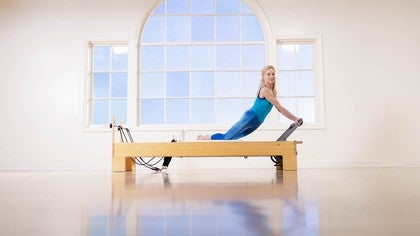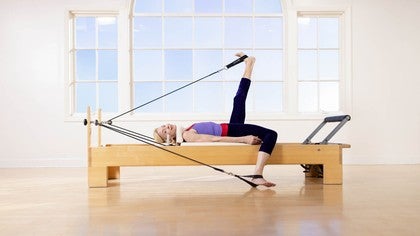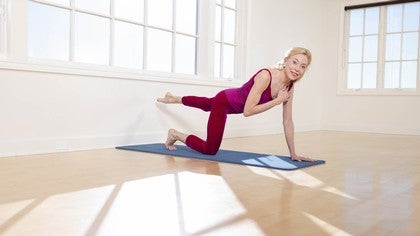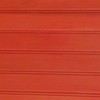Description
Watch this discussion to learn more about circadian rhythm.
About This Video
Transcript
Read Full Transcript
Welcome to Pilates Anytime Articulate Reformer, awakening your body, mind. It's so useful early in your day to enjoy morning sunlight and we'll do that now together. When you set up your reformer, place three mats around the reformer so that when you come to lie on your back or when you come to stand, you'll be secure and well cushioned. We'll start with three red springs, three red springs in the heavy setting and you'll have the loops around your thighs, just above your knees. Arms resting by your sides or on your abdominals.
Externally rotate, dorsiflexion of your ankles, flex your feet and then point your toes. Little toes touch down in the springs. Breathing in and exhale. Inhale, internal rotation. Exhale, external rotation.
We'll have two more of these circles in the current direction. Reverse direction, knees inward, heels outward. As you exhale, heels reach a part down into the springs, toes point, knees separate. Exhale articulating your femur heads and your hip sockets. Continue this motion spreading wide between your sitting bones and then sitting bones narrow.
We'll have two more of these, down around and open. Intensifying your abdominal current from pubic bone to chest bone. We'll keep the current springs, take the loops off of your thighs, park the loops around the shoulder rests and have your heels, pelvis with the greater trochanter width apart. Keeping the front of one heel on the bar, the other foot crosses behind. As you inhale, one knee falls open to earth.
As you exhale, lift and rotate. So you're in a bridge, your pelvis is turning. Pelvis and lumbar spine, they're rotating but your head, neck and eyes, they are looking straight ahead. Shift your pelvis towards the open knee side and then away from it. A lateral translation will have six of these, three and, four and pressing the back of your shoulder blade in the direction of the mat so you can move away from it.
Come back to the middle. Plant the soles of your middle toes on the bar and push through your heel, sliding back and forth. As you exhale, increase the rotation. As you inhale and slide in, increase the rotation some more. Back and forth.
Steering your ceiling knee up towards the ceiling, aligning with your second, third toes. Close, de-rotate, land. The new side awaits. Plant the front of your heel in line with your sitting bone. Cross the other foot behind.
Your knees start together. Inhale to open your bent knee wide to the side, that serves as the invitation for bridging with rotation. While you're up, shift your pelvis, translate towards your open knee side and then away. Moving your pelvis over the head of your femurs and moving your pelvis side to side while your thoracic area stays fairly steady. We have two more of these, fluctuating between six and eight.
Now, the souls of your toes, your middle metatarsals, come onto the bar and as you push back, draw the tops of your inner thighs towards each other and then bend. As you exhale, rotate towards the open leg side and continue rotating in that direction. As you slide the carriage back, collect your lower rib area in the direction of your pelvis so that the volume of your thorax and the volume of your pelvis, they stay in close relationship to each other. Close one knee, de-rotate, land. Roll to either side.
Make your way up to sitting and take all the springs off. No springs at the moment. You'll be standing with your hands on the shoulder rests. And when there are no springs on the carriage, sometimes the cords, the loops will pull the carriage. So I just put the loops on the ground for the moment.
Give yourself a stance, it's pelvis width apart. The foot bar hand comes onto the shoulder rest. The riser hand comes onto the far shoulder rest, sorry. The foot hand comes to the shoulder rest closest to you. Now as you bend both knees, your straight elbow hand slide the carriage towards the risers and you take a nose dive, pulling with the close hand, pushing with the far hand and then extend both knees to return.
This time, turn your head neck and eye so you're looking through the shoulder rests towards the risers. Pivot on the souls of your toes, the balls of your feet towards the diagonal, towards the foot bar. As you bend both knees, take a nose dive and then as you bend both knees steering on the diagonal, take an ear dive so you turn your head, neck and eyes. Swivel towards the new diagonal so that your head is aiming towards the far corner near the risers. Bending both knees, pulling with your close hand, pushing with your far hand and then slide the carriage back in and cervical rotation looking through the shoulder rest at the risers.
Stay on this same side. You could either do that again or change your base of support to be more narrow. Big toes and ankle bones close by the midline and neither knee bends unless you prefer to bend your knees. Steer your sitting bones up and back and wide. Pull, push with your hands, take a nose dive and this time pushing strongly with the big toe side of your foot that's closest to the foot bar, rotate.
Stay low here and come closer and closer and closer to the risers. Swivel on the souls of your balls of your feet and aim diagonally towards the corner of the carriage near the foot bar. Steer your sitting bones up and back and wide as you take a nose dive. And then turning your head, neck and eyes, moving your shoulder blades around the curve of your thorax coming closer and closer and closer to the carriage. Swivel to the new diagonal.
As you inhale, slide the carriage towards the risers. Bring your whole torso closer to the carriage and then rotate pressing down strongly with the soul of your foot bar, big toe to keep you honest, meaning to keep the volume of your pelvis directly above your feet. Now, the new side awaits so stride on over and bring the carriage all the way home towards the foot bar end. Give yourself a comfortable base, feet, pelvis width apart. The hand closest to the foot bar is on the shoulder rest, the hand closest to the riser is on the far shoulder rest.
(chuckles) I made the same mistake again on this side, it's the shoulder rest closest to you where the foot bar hand goes. Bending both knees, steering your sitting bones wide, pulling with your close hand and pushing with your far hand and come back. And now as the carriage slides, you turn your head, neck and eyes. Ear listens towards the carriage. Keeping your feet pelvis width apart, swivel to the diagonal in the direction of the foot bar.
Inhale as you bend both knees, a forward bend, exhale to come up and inhale, pull, push and rotate. Swivel to the next diagonal towards the risers. Breathing in and return. And breathing in and return. You could either do that same sequence again or move along so that you have a more narrow base close to the midline.
Keep your hands with the shoulder rest as they are and this time keep your knees extended, the knees don't bend. As you slide the carriage pulling with the close hand, pushing with the far hand and you take a dive right on down the midline towards the carriage. Similar midline, it's just that your head, neck and eyes, they turn to look through the risers and when you are looking through the risers, stay low here and come closer and closer and closer both to the carriage and to the risers. That requires more thoracic rotation and more slide of your scapula on the curve of your thorax. Breathing in.
It's a forward bend and rotate. And while you're here, moving along to bring the carriage closer and closer to the risers, intensifying your forward bend. swivel to the next diagonal. Inhalation accompanies the carriage sliding to the risers. Exhalation as you come back in and while you're out intensify to increase your forward bend and the rotation.
Coming back from here now, it's time for feet in the straps. For this I suggest two red springs at the top setting or the heavier setting and you'll need to rescue your loops because they've been quiet on the ground. And by the way, when I make suggestions for the springs, all you have to do is look at me and go, ppsff, she is such a lightweight, which is true. So of course you customize the springs for you so that you can be most comfortable, most supported, appropriately challenged and generally happy. Okay, so you put the...
As you like, the short loop or the long loop around the soul of your foot. It depends on how you have your chords set and we have a time honored move from at least the nineties, "Dancing on the Ceiling." I remember choreographing it when I had like way too much time on my hands at the Consumer Electronics Show. So bending one knee or maybe it was a Super Show. (chuckles) Can't remember that far. So bending one knee, your legs are in external rotation.
Slide your heel behind your supporting knee, keeping your knee bent, open both legs wide to the side. What's implied here is an under curve, a scoop as you bring your heels back to the midline. Internal rotation and it's a straddle in which the soul of one foot goes towards the ground and then the inner thigh provides the impetus to come back to the midline. Whichever foot was on the ground that knee bends. Keeping your knee bent, open both legs to the side, pushed with the soul of your bent knee foot.
Your heels meet at the midline, internal rotation and your foot slides in the direction of the ground. The other leg is in internal rotation with abduction. The top of your inner thigh pulls in. Whichever foot was on the ground, that knee bends. Keeping your knee bent open both legs wide to the side.
What's implied is an under curve, bringing both heels to meet at the midline. Internal rotation with a straddle and then pull inward bending one knee. Keeping your knee bent open both legs wide to the side. The bent knee heel pushes into the foot strap and we have last one of these. Staying at the midline, abducting away from it.
Pulling towards the midline and going away from it in internal rotation. Pulling in with the straight leg, inner thigh. Moving on now to the next event. It's going to be hip circles but maybe not your familiar version of them. External rotation heels together at the midline, bending both knees, heels are still together.
Now, keep your knees bent at the current angle. Don't change the angle of your knees but open from the hip joints. So if you were back in the ballet class of your childhood, you would be in second position, grand plie. So we'll just get at it here and make ovals. Your feet, they will draw ovals or ellipses while you articulate in your hip sockets.
We have four more of these stirring from in to out and in to out. Reverse the direction. It'd be en dedan if we were still in ballet class and if you've never been in ballet class that's not an impedance from doing this move. You can still benefit from it at any age. Pelvis is fairly steady as you articulate in your hip sockets.
Moving on to the short spine stretch, we'll take the arms off the carriage now so that your arms and palms are not available for ballast or for balance. We'll do a number of variations of short spines starting in parallel. Pike, scoop in above your pubic bone. Peel your pelvis and spine up to stand between your shoulder blades. Staying in parallel, bringing your kneecaps in the direction of your eyebrows or your eye sockets.
Roll down and push out. External rotation which is the more familiar rendition, pike. Scoop in and peel your pelvis and spine up. While you're up, heels stay together aiming your knees wider than your ears in the direction of the shoulder rest. Return the back of your lungs, the back of your ribs, the back of your pelvis.
What's left or what's next, internal rotation. Spiral inwards through your femurs. Aiming the light from your kneecaps towards the midline. Internal rotation, spiral from your femurs makes a deeper demand I think for your abdominal activation. Knees together, heels wide apart.
Knees towards your forehead, your third eye, roll down your spine and now turn all toes, both knees to the right. You could spiral your arms to the right also, pike. Staying long on the left side of your waist. Roll up to stand between your shoulder blades. Now, increase the rotation so you aim your knees beyond the shoulder rest on the right and then roll down on the right side of your lung, the right side of your ribs, the right side of your pelvis, come to the middle and then turn all toes, both knees to the left, pike.
Separate your feet maybe sitting bone width apart, scoop in. Peel your pelvis and spine up, bending both knees, steering both knees wide to the left side of the shoulder rest and then rotate more and come down on the back of your left lung, your pelvis and come back to the middle. Do one more short spine stretch of your favorite direction, pike, scoop in. So if any one of those variations caught your attention, and you particularly like it or find it particularly strange. Do it again just so you have the satisfaction of revisiting it.
Off with these straps now, off with these loops. You will come to sitting and you'll park the... We're going to have no springs. So put the loops down on the ground and take all the springs off and bring the foot bar down. Now once the foot bar is down, you'll be seated facing away from the foot bar, facing diagonally away from the foot bar.
You'll have one hand on the standing platform and it can be as you choose. It can be forward on the standing platform at the middle of it or at the back of the standing platform. As you progress through the cla... As you practice the class again in the future, if you're familiar already with one placement of your hand, then you can try out another. The opposite hand gets the shoulder rest and it can be the shoulder rest forward or the shoulder rest back.
Now, one size never fits all. So depending on the dimensions of the reformer and depending on the dimensions of you, you may need to vary where you sit in order to have a comfortable ground force with your hands. Now, as you push the carriage away, I am so wrong about no springs, is that true? Now I'm doubting myself. I think it's best to have one yellow spring.
I'm so sorry, I misled you, okay. Yeah. (chuckles) Last night's rehearsal was a long time ago. Alrighty, as you push out, rotate to look over your shoulder and as you come back, rotate to look over the other shoulder. Rotation and rotation.
So your hands are fixed and you're rotating. Now, as the carriage slides, scan the heavens for signs of intelligent life. So you're in extension and rotation and then flexion and rotation, breathing in and exhale and breathing in and exhalation. Reverse, flexion, extension and rotation so that you create an undulation of your thorax. Two more of these.
Change the placement of your hand. If you have had your hand forward you can move it back or if it's already been back, rotate more so that you can have your palm down on the frame behind you. As you push the carriage out, you intensify the pressure through both hands. As you push the carriage out, turn to look over your frame hand and then turn to look over your shoulder, rest hand. Rotation and rotation.
You add extension and flexion, extension and flexion, extension. Reverse the direction, flexion and extension. When your hands are fairly steady then it encourages more scapular motion around your thorax. You're well prepared now for a version of the mermaid. So you could either stay seated with your feet on the ground or if your hips and knees will accommodate, then you come to this more conventional mermaid sitting position.
Putting the hand back on the standing platform, side bend so your ear listens to your shoulder. As you slide the carriage out, keep your shoulder rest, sitting bone on the ground as long as you can. Increase the side bending, so you sweep the ceiling, bringing your top hand in the direction of your bottom hand. Rotate to face the ground. While you're here, slide forward in the direction of extension and slide back.
You have two more of these, appreciating the sliding of your scapula that you already prepared. Bring the forward hand next to the back hand and translate side to side. Shifting your ribs away from your knees and towards them, away and towards. The translation has prepared you for extension and rotation. Looking over your back shoulder, we have two more of these and then come low, stay really low.
De-rotate, sweep the ceiling, hold on to the back shoulder rest. Rotate to hold onto the front shoulder rest. Using the push-pull of your hands, your arms turn to look over your back shoulder. Wrap your arm around behind and turn your head, neck and eyes opposite where your torso is rotating. Change now to the next side.
So spin around and as before, when your seated diagonally, you choose where to place your hand on the standing platform. As you push your hand into the standing platform, turn rib shoulders, head, neck and eyes to look over your shoulder and then over your other shoulder. Rotation and rotation and rotation. Scanning the heavens, looking up, extension and rotation and then flexion. Breathing in usually accompanies extension and exhale usually accompanies flexion.
Breathing in. Reverse the direction, stay inflection. Then undulate from your pelvis through your thorax, through your head. Your gaze, your eyes, they are sweeping the room or the environment if we're so fortunate to have such a glorious environment. Bring your hand now to its second location.
Could be a different place on the standing platform. Could be on the frame. As you press your hand into the frame that facilitates the carriage sliding and you turn to look over your shoulder. And then the other way, sliding out an in and sliding out an in. Adding some new dimensions, extension and rotation and then looking down towards the carriage.
Looking up and looking down. Once more, sometimes things are looking up and other times they're looking down. Change down and up. But no matter what's your point of view, it's always possible to change your point of view, to change your frame of reference and movement will sure help do that. Now, philosophy aside, come onto the mermaid because it's...
'Cause we came here to move not to philosophize. Your hand is on the back shoulder, the back platform. As you side bend your ear listens to your shoulder, which then goes in the direction of the ground, sweeping up as if your top fingers could reach for your bottom hand, not remotely there, not on this side. Hands wide apart, extension and rotation. Organizing your shoulder girdle as you increase your extension, whichever is the front hand, bring it next to the back hand and then translate.
Shifting your ribs away from your knees and towards where your knees are aiming. Now you maintain this both hands next to each other. Rotation to look over your shoulder and then towards the ground. Inhalation usually accompanies extension and then exhalation. Breathing in and out.
Come low, stay really low and de-rotate. Sweep the ceiling, bring your hand to the shoulder rest, sweep the ceiling and rotate. While you're here, lift your chest bone, lift your gaze to look over your shoulder and then turn your head, neck and eyes away from where your ribs are turning. Come out of this now and it's time to come to the ground to the mats. Take the spring off.
Good thing I erroneously put the loops on the ground so we don't need to put them on the ground again. They're already where they belong. You will however need some cushions to blanket on either side of the shoulder rest 'cause different reformers have many... Lots of different architectures around the shoulder rest and it will be helpful for you to cushion the bones of your feet around the shoulder rest. Keeping the carriage, although the carriage has no springs, you keep the carriage close to the foot bar and you come to lie on your back so that the inner borders of your feet, they hug the shoulder rest and you have...
You're close enough to the carriage so that your knees are bent at about 90 degrees. Now, push down with your heels onto the carriage surface and then slide the carriage towards the risers. Yes this is correct. There are no springs on here and that's for... (chuckles) That's for your wellbeing because when you get to bridging this'll be more challenging.
Right now you're saying, what are we doing here? Well, this is a medial glide of your hip joint, sliding out and in. Best you can, you keep your pelvis fairly level on the ground. So this is a cause on side bending rather than rotation. Whichever foot is closest to the springs, that leg gets its own turn for three of these and then you change feet.
Whichever foot is closest to the riser, it gets its own turn also. Plant both feet, interlace your fingers, palms together in line with your chest bone. Anchor the backs of your heels into the carriage. When the carriage is all the way home to the spring and although there are no springs, lift up. Now, as you slide the carriage out in a bridge, carry your straight elbow, hands on the diagonal and then coming back to the middle.
Inhalation usually accompanies knee extension, exhalation, coming back in. This is three and we'll have three more for a total of six. Sliding out and in. Pushing away and then drawing your heels towards your sitting bones and pushing away. Land your pelvis.
You'll stay on this side of the reformer and you'll come to lie on your side preparing for side plank. So you have your lower leg on the carriage with your foot against the shoulder rest. Now, if this particular orientation is not right for you, build up a platform of mats so you can start higher. To get accustomed to this, you slide the carriage out and in and then prepare for your side plank. Come onto your bent elbow forearm, plant both palms on the ground.
Lift up your pelvis and lift your leg up also and while you're up, it's hip extension and hip flexion. Sliding out and in, sliding out and in. Continue this motion and if things are going reasonably well then whichever is your front hand or what... Yeah, whichever hand you can take off the ground, take it off the ground and continue in your side plank sliding. We'll prepare now for the new side, cushion the shoulder rest so that when you come to lie on your back with your knees bent you can have your inner child know, your inner feet hugging the shoulder rest.
As you exhale, slide the carriage towards the risers. Inhale to return. We have three total of these. Keeping your pelvis fairly steady as you slide. Keeping one foot in contact with the shoulder rest, lift the other leg.
So each leg has a chance to solo. That's what it's doing. Change to the next side. And this will encourage a medial and lateral hip glide and it also prepares you for bridging, which is what's coming up next. Palms together, fingers interlaced, pressing the backs of your heels onto the carriage and return.
You can inhale this time as you slide away from the midline and exhale to return. Slide away. Whichever hand is furthest from the risers, that's the hand that pulls and then the other hand pulls you back to the midline. And once again. Change now to come to lie on your side, so your knees are bent.
And rather than lying on your side, come onto your bent elbow forearm, plant your foot against the close shoulder rest and slide the carriage back and forth. Getting accustomed to hip extension and hip flexion. Now, press your palms, your bent elbow forearm into the ground and slide the carriage back and forth. Initially, you could rely on the additional stability provided by your palms. And then if things are going reasonably well, take your close palm off of the mat so you can continue your dynamic side plank.
Two more of these with more shoulder demands. Come down from here now and we'll prepare for standing. Rather than having the cushion mats by the shoulder rest, you can put them on the edge of the standing platform. I suggest one blue spring for standing. You'll be standing with your foot next aligned with the shoulder rests and the other foot on the frame or the platform.
One hand's on the shoulder rest furthest from you, the other hand on the side of the carriage. Bending your knee, shift towards the standing platform towards the frame. And then as you extend your knee slide to the risers, moving your pelvis over the head of your femurs, sliding the carriage side to side, keeping both elbows extended and you're snugging your femur head as one does into the hip socket. Now, take your hand off the edge of the frame of the carriage and put it on the shoulder rest. Bending your knee shift towards the foot bar and as you extend your knee you rotate, pulling with your close hand, pushing with your far hand, your ear listens towards the carriage.
Bend and shift, extend and rotate. Bend and shift, extend and rotate. Now the next one you make pulses further and further along the track, bringing the carriage closer and closer to the risers. Coming up from here, the new side awaits. So walk around and if it's not so convenient for you to have your foot aligned with the shoulder rest, then stand your foot wherever you feel the most comfortable, the most secure so that you have a good foot to stand on.
Shifting towards the foot bar and then sliding towards the risers. Steering your knee over your second, third toes, steering your sitting bones up and wide behind you. And for that matter, steering your collarbones wide also. Snugging your pelvis and your femur head close together. Now, change your foot bar hand to the shoulder rest closest to you.
And now we combine the first move with the second one, which is a rotation of your thorax with respect to the pelvis. Bend. Extend, lowering your ear in the direction of the carriage, bend and extend. A reminder that you don't move your head in the direction of the far riser, but you keep the axis of your torso perpendicular to the springs. So it's a rotation, more of an axial rotation than it is a side bend.
Bringing your ear closer and closer and closer to the carriage. Coming up from here, you'll be standing now, standing at the end of the reformer, standing at the foot bar end of the reformer. Stand with your heel aligned with the edge of the frame, the corner of the frame and your foot forward in hip flexion. Slide the carriage out and in. You have one hand on the foot bar and one hand on the frame or as it suits you, both hands on the frame.
Extend and bend and extend and bend. Unlike the previous exercise, as you extend your knee, given that your foot's on a moving surface, there'll be an internal rotation spin of your femur that moves weight towards the big toe side of your foot and then an external rotation spin to come to vertical. Sliding out and in and out and in. Now, as the carriage slides, rotate away from the carriage and then rotate towards it. So it's a version of thread the needle with the outside arm reaching across the midline and then the inside arm reaches across.
Rotation, two more of these. Come to vertical, come to standing. You could hold onto your bent elbows and carry your arms above your head, sliding out and in. And as the carried slides turn away from it and then turn towards it. Turn away and towards.
Two more of these still steering your knee over your second third toes. Come down from here and the next side awaits. So you'll stand towards the back of the frame with your foot forward on the carriage. Sliding out and in. This has more of a force of adduction and abduction.
And then whichever is the outside arm, it turns away from the carriage and towards it, away and towards and away and towards. Change arms. Last two and, last one. Come to vertical, standing upright. Take a hold of your bent elbow forearms high above your head.
And as the carriage slides away, plant the soul of your big toe firmly so you can turn away from it and towards it. Turn away and towards, last two of these and. Last one. Now rotation is considered the gateway to extension. Sounds like a gateway drug, but I don't mean it that way.
Rotation is the gateway to extension. You've done so much rotation, you are well prepared for extension. Prior to that, we'll prepare with some quadruped abdominal motions. Now, you will advance to doing this exercise with no springs and if it would be wise and safe to do so, you could start with a blue spring or even a red spring and then gradually decrease to a yellow and to none at all. Both hands to the same side of the frame or the standing platform.
Windshield wiper both feet to the opposite diagonal. So you've created a diagonal. And as the carriage slides, turn pelvis, ribs, shoulders, neck, head and eyes to look over your shoulder behind you and then return. Probably wise to exhale as you go back and inhale as you come forth, breathing out. We have three more of these on this side and you could change up the breath pattern if that makes you feel more secure.
Change now to the next diagonal. Swing both feet opposite where your hands are and turning your pelvis towards the outside hand to look over your shoulder and return. Exhale, you start with hip extension, rotation and return. This surely activates the spiral myofascial continuity, along with really the entire neuro myofascial system because no continuity, no line acts alone. Now let's set the springs and the foot bar for your down stretch, you have options on the level of the foot bar, probably the lower the foot bar the greater the opportunity for lumbar extension.
So you choose at which level to place your foot bar. Then for springs, you choose the springs that will provide enough compression support for your front torso and not so much compression that there is disturbance for your wrists or your elbows. Hands wide apart on the foot bar, you have your toes towards the shoulder rests and you have options with those as well. You could have your toes in dorsiflexion with your feet against the shoulder rest. That's going to throw a little bit more weight towards the anterior aspect of your knee, put more weight on your patella.
And if you have the tops of your feet on the ground, the weight's more distributed on your shins. Palms are facing back towards your torso. As you shift your pelvis forward it's hip extension, sliding back, back, back, back, back, back and return. Exhalation, breathing out. (exhales) And coming up.
Given that this is articulate awakening reformer, extension is the awakening aspect of the spine or of organ physiology to be an extension. Now, no surprise to you, we have extension and rotation, both hands to one side. Rotate looking over your shoulders, sliding back and coming up. We have two more of these on this side. Widen both collarbones, particularly the one that's closest to the outside of the frame.
Change to your new side. Sliding back and up and. Whichever shoulder blade belongs to the outside hand, slide that shoulder blade towards the opposite pelvis. For single arm, lighten the spring as you prefer and we'll go to the first side again, we have rotation and whichever is the outside arm, it reaches around behind you. And rotate and rotate.
Change to the next side. We'll finish now with both feet on the carriage and hands wide apart. Rotate so that you bring one hand to the outside ankle and slide back and forth. Change to the next side. Thank you so much for joining us at Pilates Anytime.
I'll look forward to being with you again soon, I hope. Bye for now.
The Teacher's Corner: Spike Protein Induced Conditions
Comments
You need to be a subscriber to post a comment.
Please Log In or Create an Account to start your free trial.




















